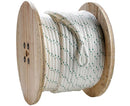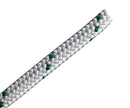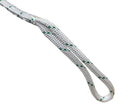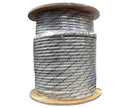









Payment & Security
Your payment information is processed securely. We do not store credit card details nor have access to your credit card information.
These products are all Made to Order
Which means they are non-cancelable and non-refundable
Minimum Order Quantities May Apply
Description
Composite Double Braid Polyester Pulling Rope, Heavy Duty
This professional grade heavy duty composite double braid pulling rope is available in 3/8", 7/16", 1/2", 9/16", 5/8", 3/4", and 7/8" diameters. It has shock absorption properties in common with nylon, with much greater tensile strength compared to nylon and polyester. Ideal for pulling, this composite polyester pull rope offers superior resistance to abrasion, exposure to sunlight, and most chemicals. It has factory spliced pulling eyes at each end. This type of polyester pulling rope is ideal for heavy duty cable pulling, especially where multiple cables are being installed.
Composite double braided polyester pulling rope has a low stretching tendency with a tensile strength matching the maximum pulling force to be utilized. The minimum break strength varies depending on the diameter size but ranges from 5,000 lbs. per foot to 32,000 lbs. per foot. Approximate density ranges from 4.5 lbs. per 100 feet to 25.0 lbs. per 100 feet. Most sizes are supplied in the following three lengths 300', 600', 1200' and are supplied on a durable wooden spool.
Features
Features
- Factory spliced pulling eyes at each end
- Heavy duty professional grade
- Double braided
- High tensity, low stretch polyester double braided pulling rope
- Breaking tenacity: 7.0-9.5 grams denier
- Wet strength/dry strength: 100%
- Shock load absorption ability: Good
- Specific gravity: 1.38
- Floats: no
- Elongation percent at break: 12-15%
- Creep (extension under sustained load): low
- Water absorption of individual fibers: <1%
- Dielectric properties: good
- Resistance to UV in sunlight: Excellent
- Resistance to rot and mildew: excellent wet or dry
- Surface abrasion resistance: excellent
- Internal abrasion resistance: excellent
- Melting point: 490-500 degrees
- Resistance to acids: good
- Resistance to alkalis: fair
- Resistance to oils and gas: very good
Specifications
Specifications
Please See Our Care and Use in Additional Information
Additional Information
Proper Care and Use
Warning: Misuse of Ropes Could Result in Serious Injury
CAUTION: Use of Working Loads
Because of the wide range of rope use, rope condition, and exposure to the various factors affecting the rope, it is impossible to make blanket recommendations as to the correct choice of rope to use. However, we have provided the tensile strength for each diameter and type of rope. These strengths are based on tests of new and unused rope, with appropriate splices. Proper choice, care and inspection of the rope are essential for reasonably safe use of the rope. Consult your cordage vendor for proper use.
Dynamic Loading Voids Normal Work Loads
Dynamic Loading occurs when rope is subjected to sudden or extreme stress. Figures given as working loads are void if rope has been subjected to dynamic loading, high temperatures, long periods of load, extreme stress, improper storage.
Effect of Temperature on Tensile Strength
The tensile strength charts apply to ropes tested at normal room temperature (70°F). Ropes have lower tensile strength at higher temperatures. Continued exposure at elevated temperatures causes permanent damage.
Avoid Abrasion
All ropes should be protected against sharp edges and abrasive surfaces. When worn areas are visible, the tensile strength is compromised. Protect the rope's surface with chafing gear around the rope.
Avoid Chemicals
Acids and Alkalis are damaging to ropes and fibers. Caution should be used when ropes are used around building cleaning acids, cast soda and paints. Proper inspection should be made of rope prior to use.
Rope Inspection
Rope Inspection should be a continuous process that takes place before, during and after each use. When fiber shows wear in any given area, the rope should be re-splices, downgraded or replaced.
Knots and Splicing
Splicing should be used instead of knots. Knots can decrease a rope's tensile strength by up to 50%
Rope Storage
All ropes should be stored in a clean dry location, out of direct sunlight and extreme heat. Natural fiber ropes, if not kept dry, will rot over time, reducing tensile strengths dramatically.
Sunlight Degradation
Polypropylene and polyethylene ropes are subject to ultraviolet degradation. The product should be replaced when signs of excessive deterioration is indicated by discoloration or broken filaments. Tensile strengths may be dramatically reduced by sunlight degradation.
Dielectric Properties
Dielectric property testing applies only to new, unused clean rope and holds true only under these ideal conditions. Dirt, grease, entrapped moisture, or other contaminants will increase conductivity greatly. Nylon or natural fiber ropes would not be used around energized lines. Rope dielectric properties must be tested under actual operation conditions.

